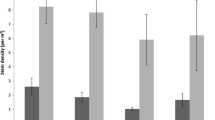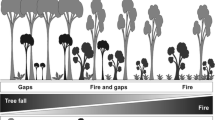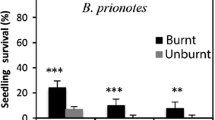Abstract
Members of the widespread arid Australian mulga (Acacia aneura) complex are fire-sensitive shrubs or small trees that can resprout epicormically following low-severity burning, but are readily killed by high-severity fire. The seeds of many species of mulga are stimulated to germinate by heat during burning, although post-fire regeneration rates are unpredictable. Here, we investigated whether variability in post-fire mulga recruitment relates to the relationship between fire severity and soil heating during fire, which may kill, leave unaffected, or stimulate the germination of buried seeds. This hypothesis was examined in central Australia on slender mulga (A. aptaneura), by experimentally investigating (a) seedling recruitment rates under different fire severity classes, (b) the germination and lethal temperature thresholds of seeds, (c) soil temperatures during fires of different severity classes and (d) the emergence depths of seedlings beneath high- and low-severity burnt plants. We found that post-fire recruitment was significantly lower beneath low-severity burnt and unburnt plants than high-severity burnt plants. This result was explained by the finding that maximum germinability of mulga seeds occurs after heating to between 80 and 100 °C, and that these temperatures are not achieved in unburnt patches or low-severity burns at depths where the majority of the seed bank is known to occur. Despite the increased regeneration observed after high-severity fire, post-fire recruitment was highly variable between sites, independent of fire severity. This indicates that while heat-stimulated germination may confer on mulga a risk-spreading strategy to a range of fire severities, post-burn recruitment may not always offset high adult death rates following high-severity fire.





Similar content being viewed by others
References
Arianoutsou MW, Thanos CA (1996) Legumes in the fire prone Mediterranean region: an example from Greece. Int J Wildland Fire 6:77–82
Auld TD (1986) Population dynamics of the shrub Acacia suaveolens (Sm.) Willd.: fire and the transition to seedlings. Aust J Ecol 11:373–385
Auld TD (1987) Population dynamics of the shrub Acacia suaveolens (Sm.) Willd: survivorship throughout the life cycle, a synthesis. Aust J Ecol 12:139–152
Auld TD (1995) Soil seed bank patterns of four trees and shrubs from arid Australia. J Arid Environ 29:33–45
Bastin G, Allan G (2012) After the smoke has cleared: 2011 fire in central Australia. Range Management Newsletter NO. 12/2, Australian Rangeland Society, Australia, pp 3–6
Bell DT, Plummer JA, Taylor SK (1993) Seed germination ecology in southwestern Australia. Bot Rev 59:24–73
Bond WJ, van Wilgen BW (1996) Fire and plants. Chapman and Hall, London
Bradstock RA, Auld TD (1995) Soil temperatures during experimental bushfires in relation to fire intensity: consequences for legume germination and fire management in south-eastern Australia. J Appl Ecol 32:76–84
Burrows WH, Beale IF (1969) Structure and association in the Mulga (Acacia aneura) lands of south-western Queensland. Aust J Bot 17:539–552
Céspedas B, Luna B, Pérez B, Urbieta IR, Moreno JM (2014) Burning season effects on the short-term post-fire vegetation dynamics of a mediterranean heathland. Appl Veg Sci 17:86–96
Crawley MJ (2002) Statistical computing: an introduction to data analysis using S-plus. Wiley, England
Davies SJJF (1976) Studies of the flowering season and fruit production of some arid zone shrubs in Western Australia. J Ecol 64:665–687
Davies SJJF, Kenny SA (2013) The ages and fecundity of some arid-zone plants in Western Australia. Rangel J 35:455–468
Everist SL (1949) Mulga (Acacia aneura) in Queensland. Qld Agric J 6:87–139
FloraNT (2015) Acacia sp. holey trunk (P.K. Latz 12458). http://eflora.nt.gov.au/factsheet?id=23522. Accessed 16 Dec 2015
Fournier DA, Skaug HJ, Ancheta J, Ianelli J, Magnusson A, Maunder M, Nielsen A, Sibert J (2012) AD model builder: using automatic differentiation for statistical inference of highly parameterized complex nonlinear models. Optim Methods Softw 27:233–249
Gill AM (1981) Adaptive responses of Australian vascular plant species to fires. In: Gill AM, Groves RH, Noble IR (eds) Fire and the Australian biota. Australian Academy of Science, Canberra, pp 243–272
Griffin GF, Friedel MH (1984) Effects of fire on central Australian rangelands. II changes in tree and shrub populations. Aust J Ecol 9:395–403
Harding J (2012) Stratified sampling. Wiley, New Jersey
Harrington JF (1972) Seed storage and longevity. In: Kozlowski TT (ed) Seed biology. Academic Press, New York, pp 145–245
Hodgkinson KC (1991) Shrub recruitment response to intensity and season of fire in a semi-arid woodland. J Appl Ecol 28:60–70
Hodgkinson KC (1998) Sprouting success of shrubs after fire: height-dependent relationships for different strategies. Oecologia 115:64–72
Hodgkinson KC, Oxley RE (1990) Influence of fire and edaphic factors on germination of the arid zone shrubs Acacia aneura, Cassia nemophila and Dodonaea viscosa. Aust J Bot 38:269–279
Keeley JE (1977) Seed production, seed populations in soil, and seedling production after fire for two congeneric pairs of sprouting and non-sprouting chaparral shrubs. Ecology 58:820–829
Keeley JE, Fotheringham CJ, Baer-Keeley M (2005) Determinants of post-fire recovery and succession in mediterranean-climate shrublands of California. Ecol Appl 15:1515–1534
Keeley JE, Pausas JG, Rundel PW, Bond WJ, Bradstock RA (2011) Fire as an evolutionary pressure shaping plant traits. Trends Plant Sci 16:406–411
Latz PK (1995) Bushfires and Bushtucker. IAD, Alice Springs
Leavesly A (2008) The response of birds to the fire regimes of mulga woodlands in central Australia. Dissertation. Australian National University
Letnic M, Dickman CR, McNaught G (2000) Bet-hedging and germination in the Australian arid zone shrub Acacia ligulata. Austral Ecol 25:368–374
Maconochie JR (1971) Fire—its significance in the development and management of vegetation of the arid zone of central Australia. In: Proceedings of the Tropical and Arid Fire Symposium. Darwin, Australia
Maslin BR, Reid JE (2012) A taxonomic revision of Mulga (Acacia aneura and its close relatives: Fabaceae) in Western Australia. Nuytsia 22:129–267
Miller AL (2010) AOSA/SCST Tetrazolium testing handbook 2010 edition. A manual prepared by the Tetrazolium subcommittee of the Association of Offical Seed Analysts and the Society of Commercial Seed Technologists
Miller JT, Andrew RA, Maslin BR (2002) Towards an understanding of variation in the mulga complex. Conserv Sci 4:19–35
Moreira B, Pausas JG (2012) Tanned or burned: the role of fire in shaping physical seed dormancy. Plos One 7(12):e51523
Moreno JM, Oechal WC (1991) Fire intensity and herbivory effects of post-fire resprouting of Adenostoma fasciculatum in southern Californian chaparral. Oecologia 85:429–433
NAFI (2015) North Australian Fire Information—fire map regons from the southern Northern Territory. http://www.firenorth.org.au/. Accessed 10 Oct 2015
Nano CEM, Clarke PJ (2010) Woody–grass ratios in a grassy arid system are limited by multi-causal interactions of abiotic constraint, competition and fire. Oecologia 162:719–732
Plummer M (2003) JAGS: a program for analysis of bayesian graphical models using gibbs sampling. In: Proceedings of the 3rd international workshop on distributed statistical computing (DSC 2003), March 20–22, Vienna
Preece PB (1971) Contributions to the biology of mulga II. Germination. Aust J Bot 19:39–49
R Core Team (2014) R: a language and environment for statistical computing. R Foundation for Statistical Computing, Vienna, Austria. http://www.R-project.org/
Sinclair R (2005) Long-term changes in vegetation, gradual and episodic, on the TGB osborn vegetation reserve, Koonamore, South Australia (1926–2002). Aust J Bot 53:283–296
Tozer MG (1998) Distribution of the soil seedbank and influence of fire on seedling emergence in Acacia saligna growing on the central coast of New South Wales. Aust J Bot 46:743–755
Ward BG, Bragg TB, Hayes BA (2014) Relationship between fire-return interval and mulga (Acacia aneura) regeneration in the Gibson Desert and Gascoyne-Murchison regions of Western Australia. Int J Wildland Fire 23:394–402
Wison AD, Mulham WE (1979) A survey of the regeneration of some problem shrubs and trees after wildfire in western New South Wales. Rangel J 1:363–368
Wright BR (2007) Fire ecology of the spinifex hummock grasslands of central Australia. Dissertation, University of New England
Wright BR, Clarke PJ (2007) Resprouting responses of Acacia shrubs in the Western Desert of Australia—fire severity, interval and season influence survival. Int J Wildland Fire 16:317–323
Wright BR, Clarke PJ (2008) Relationships between soil temperatures and properties of fire in feathertop spinifex (Triodia schinzii (Henrard) Lazarides) sandridge desert in central Australia. Rangeland J 30:317–325
Wright BR, Zuur AF (2014) Seedbank dynamics after masting in mulga (Acacia aptaneura): implications for post-fire management. J Arid Environ 107:10–17
Zuur AF, Ieno EN, Walker NJ, Saveliev AA, Smith GM (2009) Mixed effects models and extensions in ecology with R. Springer, New York
Zuur AF, Ieno E, Elphick CS (2010) A protocol for data exploration to avoid common statistical problems. Methods Ecol Evol 1:3–14
Acknowledgments
Grant Allan from the Northern Territory Parks and Wildlife Commission is thanked for providing dates of occurrence of all fires examined in this study. The authors also thank landholders from the Haasts Bluff Aboriginal Land Trust and from Aileron, Amburla, Bond Springs, Hamilton Downs, Narwietooma and Yamba stations for allowing access for fieldwork. Danae Moore and Joe Schofield are also thanked for enabling fieldwork to take place at New Haven Wildlife Sanctuary. Jeremy Williams facilitated access to the Mt Everard sites. Tony Auld, Ken Hodgkinson and two anonymous reviewers made helpful comments on earlier drafts of the manuscript.
Author information
Authors and Affiliations
Corresponding author
Additional information
Communicated by Prof. Michael Lawes, Prof. Ross Bradstock and Prof. David Keith.
Electronic supplementary material
Below is the link to the electronic supplementary material.
Rights and permissions
About this article
Cite this article
Wright, B.R., Latz, P.K. & Zuur, A.F. Fire severity mediates seedling recruitment patterns in slender mulga (Acacia aptaneura), a fire-sensitive Australian desert shrub with heat-stimulated germination. Plant Ecol 217, 789–800 (2016). https://doi.org/10.1007/s11258-015-0550-0
Received:
Accepted:
Published:
Issue Date:
DOI: https://doi.org/10.1007/s11258-015-0550-0




